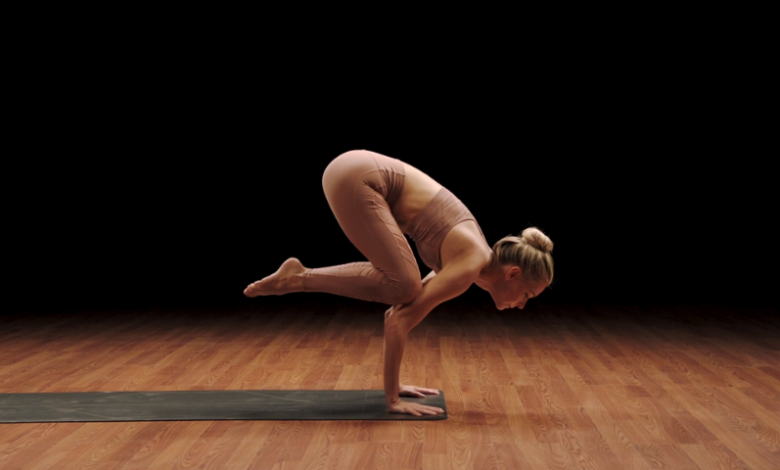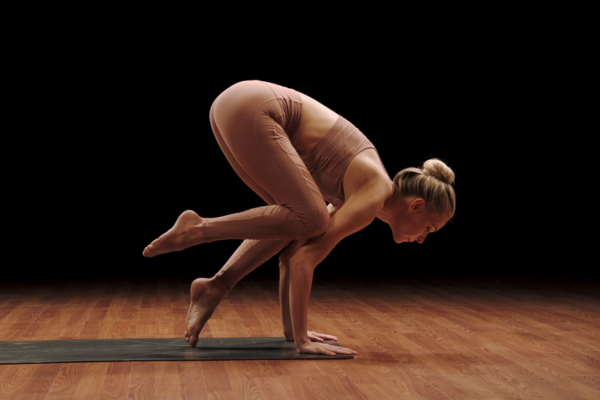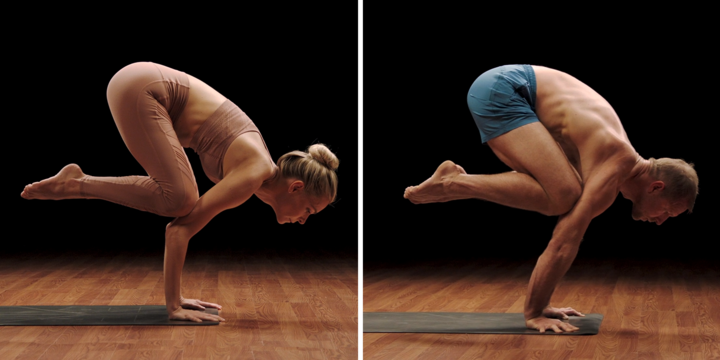How to Do Crow Pose in Yoga (Kakasana)

Yogis looking to make a foray into arm balances should try their hand(s) at crow pose (Sanskrit name: kakasana). Often conflated with crane pose (bakasana), crow offers many avenues of approach that make it accessible no matter where you are in your yoga practice.
When certain actions are accentuated — for example, engaging your core, firming your inner thighs, or flexing your spine (i.e. rounding your back) — it becomes clear that most yoga poses, or asanas, mold our bodies into repeating shapes; they just have different relationships to gravity.
When approaching crow pose with playfulness (and humility), this low-to-the-ground arm balance is a lot of fun. Here’s how to do it.
Crow Pose (Kakasana): Step-by-Step Instructions
- Start on your mat in malasana (or yogi’s squat): stand with your feet hip-width apart, and lower your body into a full squat, making room for your chest by spreading your knees. (If you’re unable to bring your feet together, take them wider.)
- Extending your arms between your knees, place your hands on the floor in front of you, elbows bent, and your knees against your triceps. Your hands should be shoulder-width apart, with your fingers spread.
- Come up on to the balls of your feet, and lean forward, keeping your heels as close to your tailbone as possible throughout the pose.
- Maintaining the bend in your elbows and keeping your gaze just ahead of your hands, shift your weight forward as you squeeze your legs onto your arms like a clamp, engaging your core muscles and rounding your back.
- Pull your kneecaps as high onto your upper arms as possible before lifting your feet off the floor. Try to keep the inner edges of your feet pressing together.
- Tilt forward, elevating your hips as high as possible. Your pelvis should be higher than your shoulders in the fullest expression of the pose.
- Hold up to one minute, breathing slowly and deeply. Slowly reverse the move to return to the starting position.
Beginner Tips for Doing Crow Pose
- One of the ultimate objectives of this pose is to get your kneecaps into your armpits, but if that’s too difficult a good way to start is with your shins against your upper arms.
- Your back should be so round in crow that it resembles the shape of cat pose in the cat-cow sequence. “I definitely recommend deep abdominal engagement, which will create flexion in the lumbar spine,” says Brent Laffoon, an instructor in BODi’s Yoga52 series of practices. When your lumbar spine is round and you feel a strong lift initiated from your navel, your weight naturally begins to shift forward, and your feet float off the floor.
- Without losing the flexion of your spine, add the counter movement of spreading your collarbones, creating width across your chest.
- Eventually, as you become more confident supporting your weight on your wrists, you can tighten the shape by squeezing your legs higher on your upper arms. This creates lift, allowing your feet to come together. “Ideally the big toes touch in crow,” Laffoon advises. “It’s not the end of the world if they don’t, but bringing them together activates the hips in a way that can help with the lift.”
How to Make Crow Pose Easier

- Play with the shift in weight to get a feel for the pose. You can stack the tops of your shins, one at a time, higher up your arms toward your armpits. Then attempt to lift one foot, putting it down, then the other, and putting it down, as you graduate to the true pose.
- Another way to work up to the pose is to start by standing on a block. The elevation afforded by the block will give you more space to clamp your knees higher up on your arms.
How to Make Crow Pose Harder
- Once you feel confident in crow pose, try placing the top of your head on the floor, forming a tripod headstand shape.
- There are infinite possibilities with crow. From here, you can move into more challenging arm balances, or use it as a transitional posture.
Crow Pose Vs. Crane Pose: What’s the Difference?

The primary difference between crow pose and crane pose is elbow angle. In crow pose, the elbows are bent and forearms vertical, typically with the legs resting on the upper arms. In crane pose, the arms are straight (or as close as possible), forearms angled forward, with the kneecaps tucked into the armpits.
Once you’re comfortable in crow pose, you can play with straightening your arms and working your knees further toward your armpits until you achieve crane. From there, you may begin working your way toward transitioning into handstands.
Benefits of Crow Pose (and Crane Pose)
Yoga as a practice is attended by a multitude of benefits backed by science, but there are several that are specific to crow pose:
- Strengthens arms and shoulders
- Trains balance
- Promotes core strength and stability



